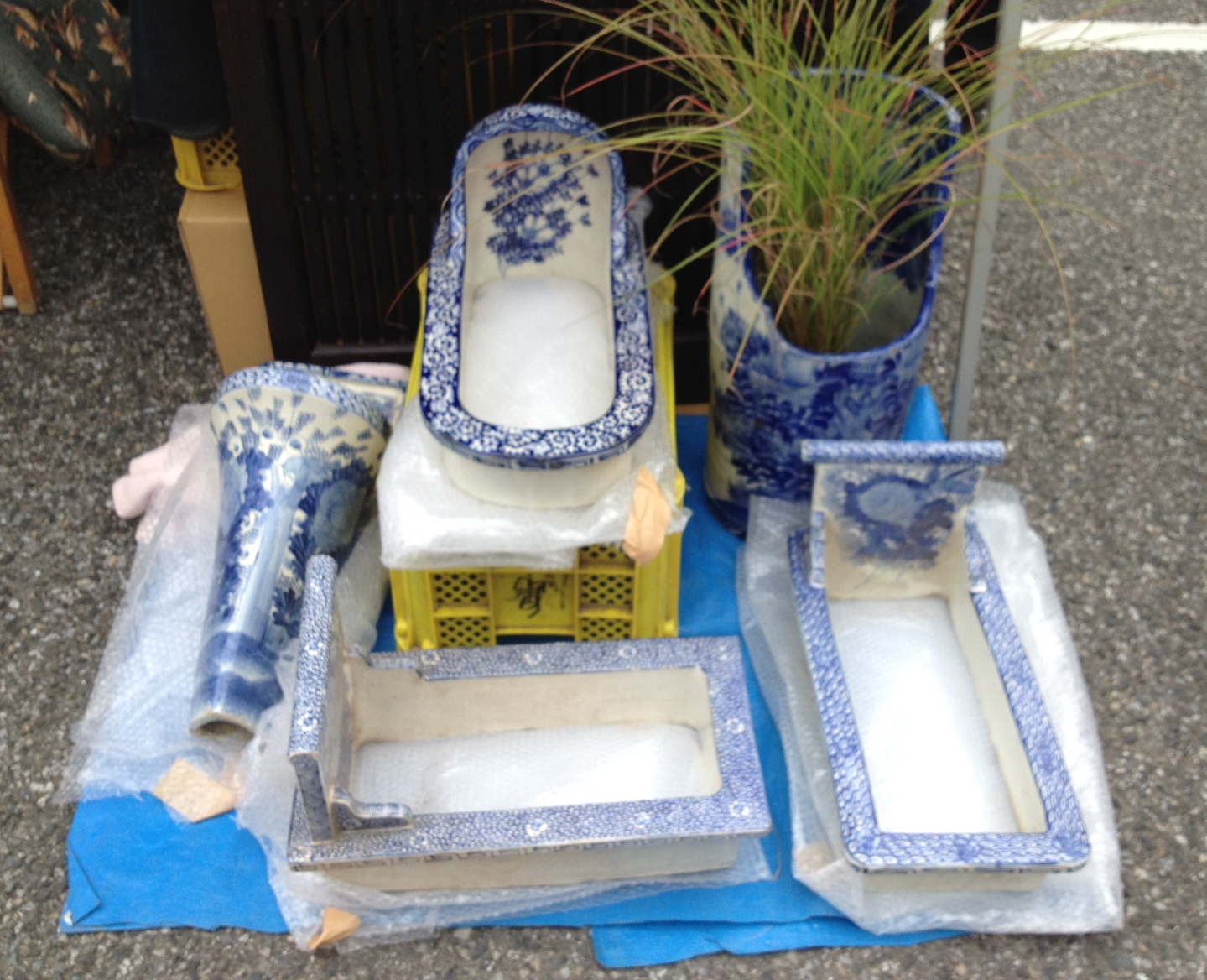
I was young, newly married, and in need of a table and chairs to serve as both kitchen and dining room table. We had the typical NYC galley kitchen in our apartment in an old 19th century school building. The space had a loft-meets-country feel and I was still pretty firmly embedded in the 19th century Americana that was my original antiques specialty, although my tendency to pull from the Aesthetic Movement was already quite marked. Quite soon after moving in we were driving home from a friend’s house in Connecticut along Route 2 or 202 or something like that, chock-a-block with antique stores along the way, so of course we had to stop. We picked up a few great things that day, including an antique clock case we turned into a medicine cabinet, but the standout find was a bargain set of six black Hitchcock chairs.
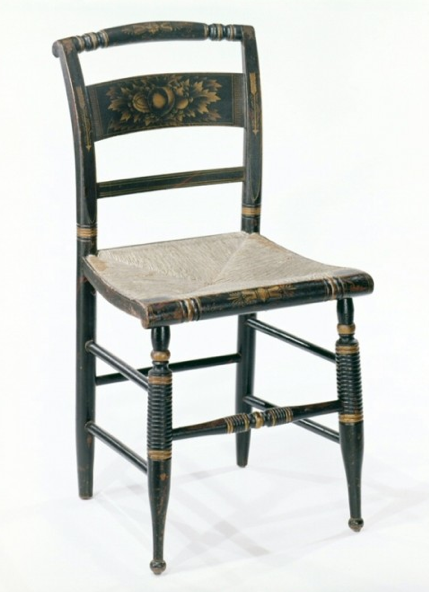 I’ve always had a weakness for Hitchcock chairs, which are so quintessentially American, but also one of the very first mass-produced pieces of furniture ever made in this country. Originally produced during the second quarter of the 19th century by Lambert Hitchcock, a Connecticut cabinetmaker, they are easily identifiable by their black or dark paint, simple Sheraton shape, gold stencilled details and rush or caned seat. It’s estimated that by the late 1820s, Hitchcock’s company was selling over 15,000 chairs per year. After closing in 1852, the company remained out of business for almost a century only to have a resurgence in the second half of the 20th century when the factory was reopened on the ongoing waves of Colonial Revival popularity. I’d date my chairs as vintage – perhaps 1960s or 70s – as the truly antique examples I’ve come across don’t seem like they could hold up to everyday wear and tear.
I’ve always had a weakness for Hitchcock chairs, which are so quintessentially American, but also one of the very first mass-produced pieces of furniture ever made in this country. Originally produced during the second quarter of the 19th century by Lambert Hitchcock, a Connecticut cabinetmaker, they are easily identifiable by their black or dark paint, simple Sheraton shape, gold stencilled details and rush or caned seat. It’s estimated that by the late 1820s, Hitchcock’s company was selling over 15,000 chairs per year. After closing in 1852, the company remained out of business for almost a century only to have a resurgence in the second half of the 20th century when the factory was reopened on the ongoing waves of Colonial Revival popularity. I’d date my chairs as vintage – perhaps 1960s or 70s – as the truly antique examples I’ve come across don’t seem like they could hold up to everyday wear and tear.
Once we had the chairs, we needed a table. I knew I wanted something that didn’t match. This doesn’t sound exciting or particularly revolutionary now, but at the time, people were still buying ‘suites’ of furniture, whether matching couches and love seats or entire bedroom and dining ‘sets’. The table had to be practical as my sweet husband was not going to stand for constant coaster/place mat/tablecloth use. The coloring of the rush seats looked great with light woods as did the dark contrasting paint. But the apartment was open like a loft and fairly dressy, so finding the right thing became a bit of a challenge as the obvious choice – a rustic farm table – didn’t seem right.
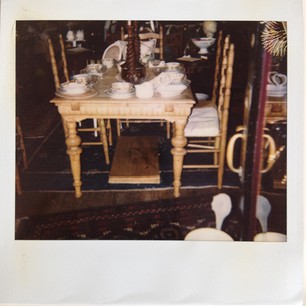 Does anyone else remember the days when the western edge of Bleecker Street was still full of antique stores, before the Marc Jacobsvication of it? There was one great mixed shop called Clary & Co (I think they may be still around on 1st dibs) that I checked in at all the time. Once day I was lucky enough to find this – a finely detailed Danish Victorian scrubbed pine table. I still have the Polaroid (!) they took for me to take home to think about it. If I recall correctly, we tied it to the roof of my parents borrowed station wagon to get it home the ten blocks or so.
Does anyone else remember the days when the western edge of Bleecker Street was still full of antique stores, before the Marc Jacobsvication of it? There was one great mixed shop called Clary & Co (I think they may be still around on 1st dibs) that I checked in at all the time. Once day I was lucky enough to find this – a finely detailed Danish Victorian scrubbed pine table. I still have the Polaroid (!) they took for me to take home to think about it. If I recall correctly, we tied it to the roof of my parents borrowed station wagon to get it home the ten blocks or so.
We were so excited by the combination but the ultimate vindication came not much later from none other than Thomas O’Brien of Aero Studios when his country house was profiled in the February 1994 House Beautiful. He had Hitchcock chairs (his high school graduation present!) pulled up to a similar pine table. He was even using an antique Empire dresser as a sideboard – as we were and are – my own first ever real antique furniture purchase. He had a glass hurricane lantern hanging above the table, just like we did – although I have to point out that his was nowhere near as beautiful as ours (a Dixie Highway find).
Over the years I started collecting every Hitchcock chair photo I came across. Earlier shots tend to have that more cluttered country feel, but all have a common denominator in that the tables and chairs mix materials successfully, from grey painted wood…
…to white…
…to more pine…
…to speckled paint treatment in a formal dining room…
…to cheery cottage sun porch…
…to cosy dining corner.
For all their country coziness, Hitchcock chairs have a very spare silhouette – and much like paper cut silhouettes which are hugely trendy again now – that old-fashioned black profile can really feel modern. So along the way, as tastes changed, designers began to pull on the simple streamlined form of the chairs and highlight that. One of the first to do so was Victoria Hagan, here with a set that have a Washington Vase back shape…
…and again here with a combo of cane and rush seated versions. Both are all about the dark/light contrast and the sculptural shape of the furniture.
Picking up and running with that same idea is architect Gil Schafer, first at his Hudson Valley home Middlefield…
…and later the exact same table and chairs moved to his apartment in New York City. Again note the combination of dark chair and rustic light table.
Schafer uses Hitchcock chairs again in his other residential projects.
A master of that simplified American vernacular, Schafer has an amazing book
The Great American House: Tradition for the Way We Live Now that should not be missed!
Another master at highlighting sculptural antique forms through light and dark is Darryl Carter, using Hitchcock chairs and a bench in this recent room from the June 2012 Elle Decor.
As a testament to their surprising flexibility, they mix with this very modern white table as well.
So this is where I stand. After long daily use, the chairs are dying. The rush seats are breaking and the art of re-rushing does not seem to exist in Japan. The wood frames are getting shaky too. I have been playing musical chairs with the wonkiest ones. And perhaps, just a little bit, I am visually ready for something new and fresh. Now don’t get ahead of yourself, I’m not talking radically new – I don’t think that is where I am heading, but maybe something new antique.
I can’t remember exactly when or where I got the idea of changing the Hitchcock chairs for Thonet style bentwood chairs, another 19th century iconic choice that has such a stylistic yet functional presence. My instincts are that the idea starts with Tom Scheerer‘s influence. His spectacular interiors are littered with different versions of classic Thonet, but he particularly likes to use No. 4, the Cafe Daum chair.
He mixes them with very modern tables extremely well.
The irony of changing to bentwood chairs is that from a historical furniture manufacturing point of view, Hitchcock chairs and Thonet bentwood chairs were almost contemporaries. Michael Thonet set himself up as a cabinetmaker in 1819 and began to experiment with bending wood, ultimately patenting a steam technique around 1840, allowing his chairs to be mass produced. Both styles of chairs represent a huge departure from the past – economically, socially and stylistically – in that they created affordable, well made, functional pieces that appealed to the new popular taste.
It wasn’t hard to come up with inspiration examples like this similar table to mine mixed with black bentwood in the Scott Weston designed kitchen of Kirstie Clements.
I’ve found numerous examples of black or dark bentwood chairs looking great with casual light wood tables. These aren’t a Thonet style, but I can’t resist including them, because the whole kitchen is so fab.
Here’s another view – I do love this kitchen.
Here a vintage marble-topped wood table and black bentwood chairs anchor a modern space…
…as they do in this older version of Muriel Brandolini‘s kitchen.
And I don’t want to rule out the idea of color as they look wonderful painted. Perhaps a Prussian Blue?
The Conran Shop sells a version of Chair No. 14…
…while Crate & Barrel sells their own version of No. 18.
A great company called Bauhaus 2 Your House sells almost every version of bentwood chair available today and they are all fully licensed.
The problem is that I need the choices to be readily available in Japan. I’ve been keeping my eyes open for modern examples or vintage ones. Geographica along the antiques hub on Meguro-dori has these dark wooden No. 14 chairs available for sale.
One of the advantages of bentwood chairs is that they are open to the mismatched look – you can charmingly mix a variety of the styles.
Goodbye Mr. O’Brien? Hello Mr. Scheerer? What do you think?



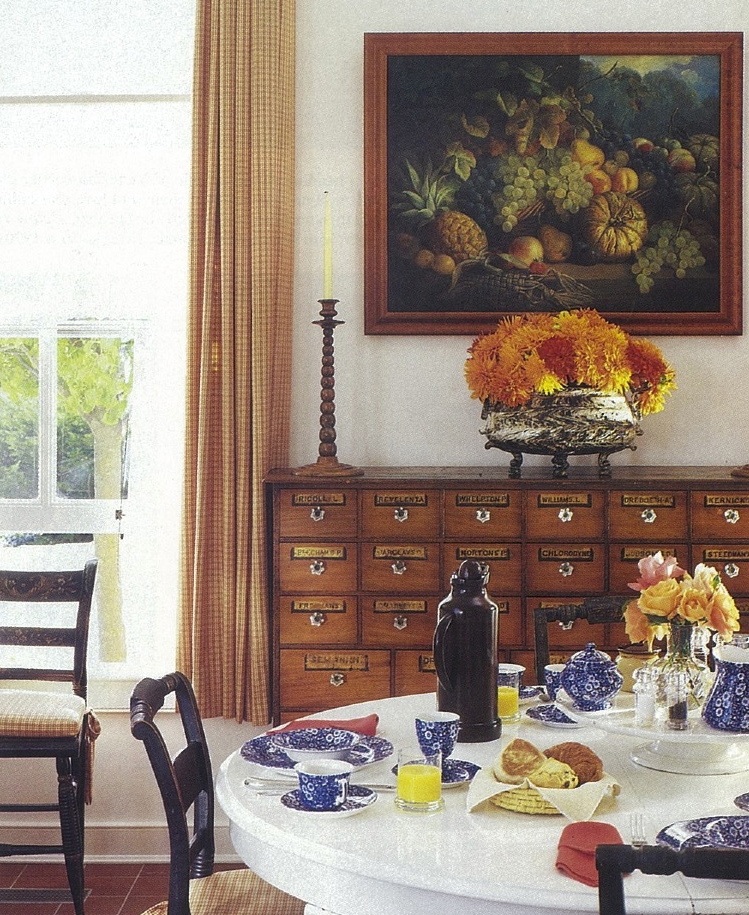










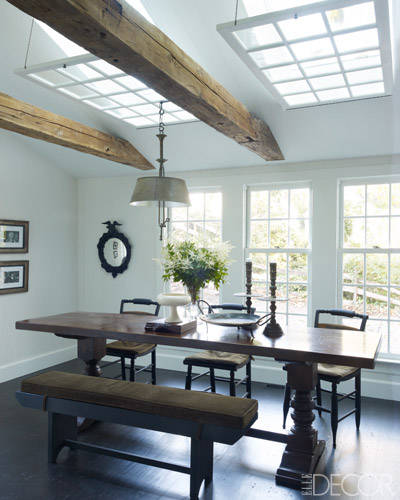





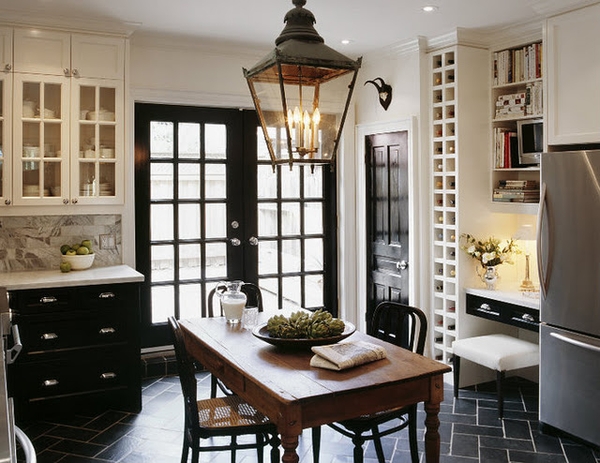
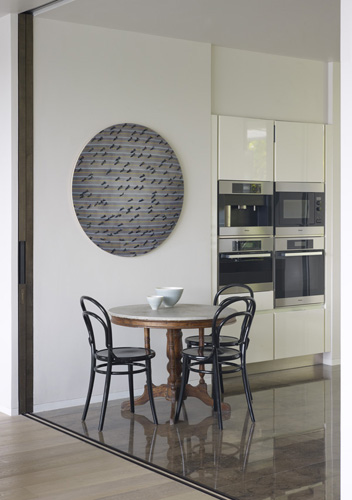





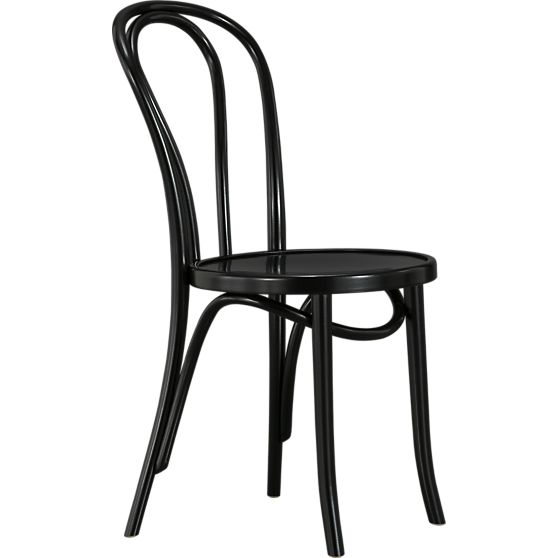





I vote you keep the Hitchcock! While in Japan get a carpenter to reset their wobbly bits…one of the best places for joinery me thinks. Out source the seat in the USA – job done! Can the seat be popped out and repaired separately or perhaps even buy new insert seats? They are beautiful chairs, they have history, and they will always be current..
I’m surprised…I would have thought you’d vote for the Thonet!
Your post is so well timed — I am so frustrated by my own dining room chairs! The next set of chairs I buy must be well-built, comfortable, and sturdy — I’ve just spent a half day regluing three of a set of 10 Windsor chairs that were loose and wobbly after only 5 years of use. I found poor construction methods — using nails, staples, or screws to hold the spindles, instead of proper, well-fitting joints and glue. My dining room is a gathering place where friends and family spend lots of time together, and the chairs have to stand up to hours of use every day.
I do like the look of bent wood chairs, and their small size works very well in small spaces, but have never found them to be comfortable. Further, the bent wood process is very difficult to replicate when you must repair a chair. We had a set of 1920’s-1930’s bent wood chairs from the dining room of a lodge owned by my grandparents, but over time, most of them broke and couldn’t be repaired. The Hitchcock chairs, however, look quite comfortable and they must be sturdy to have survived all these years. Rushing is actually a very simple craft, so those seats can be repaired. You might want to consider it a project for you and the girls — each of you do a chair and it will be fun. Rushing supplies and directions are available over the internet.
I was taking your DIY suggestion seriously until another commenter gave me some links to furniture restorers here in Japan!
I love the Cafe Daum! Simple, but so pretty 🙂 Though, I still like your chairs with that table too…
I’m loving that Cafe Daum chair too! I need one somewhere if I don’t get them for the table…
I have to agree with George. You should definitely get your chairs fixed. They’re so pretty and I’m sure you have some wonderful memories attached to them. I have Thonet chairs and I don’t think you’ll find them to be as comfortable. Although I have to admit I love them. I’m sure you’ve noticed wishbone chairs are very popular here, so there are quite a few workshops experienced in restringing seats similar to your Hitchcocks. If you do change your mind about them I’ve found three furniture workshops that could probably fix them that are not too far from you.
This one is probably closest. It’s in Edogawa-ku. They do all kinds of furniture repairs /reupholstery.
http://www.reform-shimiz.com/MENU9.htm
This one is in Hachioji. Seems they specialize in fixing seats.
http://www.a-rattan.com/index.html
and this one in Iruma, Saitama does all kinds of furniture repairs/reupholstery
http://www.azuma-kako.co.jp/
Mary, as always you are the best! I think I might have them re-rushed regardless of what I decide. I’ll let you know!
It is so much fun to learn a useful craft like rushing. I just finished re-caning a rocking chair from my grandmother — and the chair just wouldn’t be as precious to me if I had it done by a professional. Come see it when you return to your beach house!!
It’s always so hard to choose chairs! For us, anyway. Glad you had something you loved this long, and very much interested to see which bentwood chair style you find in Japan/settle on… and painted sounds FUN!
Great post and right to the point. I am not sure if
this is
really the best place to ask but do you people have any thoughts on where
to get some professional writers? Thanks 🙂
Do you mind if I quote a few of your posts as long as I provide
credit and sources back to your
webpage? My blog is in the very same area of interest
as yours and my users would genuinely benefit from a lot of the information
you present here. Please let me know if this okay with you.
Thank you!
Carnation Fixation…Ottoman Inspired Textiles | Tokyo Jinja
[…] Back on my own home front, a large remnant of a crazy colored outdoor fabric from Raoul Textiles (called Dianthus I believe) covered in giant Ottoman carnations had suggested a bright color scheme for my kitchen, designed to overcome its severe limitations and make some cohesion out of the colors already in play. The fabric is thick, durable and cleanable, making it perfect for chair cushions for the crumbling rush seats on the Hitchcock chairs. […]
Sooner or later, Google will find all new spam methods. These pre-computed
numbers, hold on in a very giant information bank for millions or URLs on the net.
* Page SEO: Your page is optimized by various means
which include, choosing the right keywords, placing them right, adding anchor text linking, adding call
to action in various places on the page.